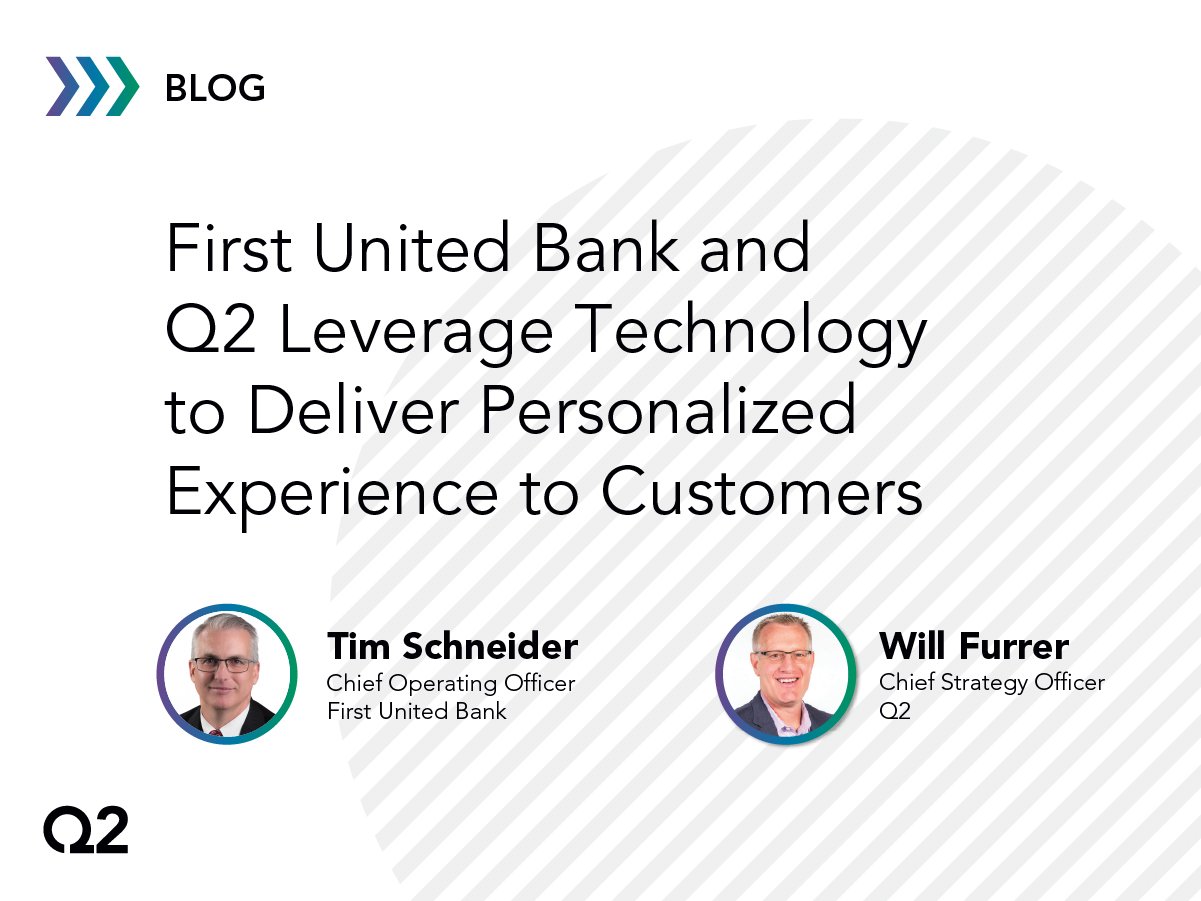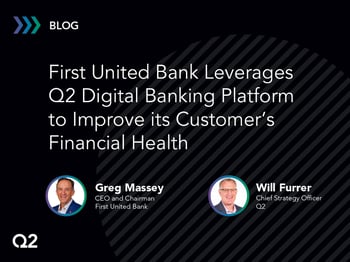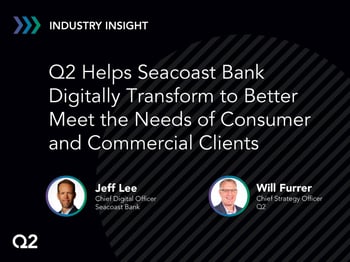This is the second of a two-part installment from Q2’s Industry Insights Executive Perspective series with First United Bank. Q2 Chief Strategy Officer Will Furrer sat down with two of the bank’s leaders at their company headquarters in Durant, Oklahoma. Established in 1900, First United Bank operates more than 85 banks, mortgage and insurance locations throughout Oklahoma and Texas. Its assets exceed $12 billion.
In part one, Furrer spoke with CEO and Chairman Greg Massey to learn about the bank’s purpose-driven mindset, Spend Life Wisely® and the importance of data and the role of technology in banking.
What follows is a transcript of the second conversation with First United Bank Chief Operating Officer Tim Schneider, which has been edited for flow and conciseness.
Will Furrer WF: I'm here with Tim Schneider, the Chief Operating Officer here at First United Bank in Oklahoma. Thank you so much for spending time with us today.
Tim Schneider (TS): Thank you for having us.
WF: You take a pretty big view of what's happening in the industry and what's happening with technology within financial services. Can you share what's happening, what trends you're seeing around technology and how that's impacting banking?
TS: I think the big change that's happened over the 20th century is that the supply chain was really around the point of sale – or basically the delivery system, whether you went to the grocery store, the mall or the bank itself. What really changed in the 21st century was the supply chain is now around the customer, whether it's delivery through the digital channel, Netflix, Amazon, or something else. We’ve got to really change the way we look at deploying the customer experience.
WF: And when you think about how that impacts banking and these branches, and you think about the buildings that you have, tell us how you flip that over to a digital presence. How has that accelerated and changed the way bankers and operating officers like you have to think?
TS: You’ve got to look at technology as – it's easy to say, but – as an enabler to handle both the physical transactions in person, and also meeting the customer where they're at. So, being able to deliver the same experience, whether it's through digital at 2:00 AM or whether the customer comes in person to meet with one of our bankers. It’s about being able to use that technology to empower them, spend more time in a relationship or mentoring conversation, and not in a transactional conversation.
WF: What do you think it's going to require over the next several years? You have your eyes set far out into the future in the way digital is going to help change your business. Talk to us about the acceleration you’re seeing, the requirements around your spend, and how that's going to continue to bring change to your brand.
TS: Anytime you see a shift or a pivot in the way you deliver services, you're going to have to shift your spend to that area. Now, again, we historically spent the money on our talent. You spent the money, and maybe the physical location itself, on building out the product set. But now, we really have to look more at spending that money in the next level of customer experience, which is in the digital channel. So, I think you're going to start to see your dollars shift, and realize that's where your investment will be.
WF: As you think about what's happening with COVID, and you think about the efforts that your team put into the Paycheck Protection Program (PPP) loans – which were very successful for you – and how you were able to move quickly over the last year, what role is technology going to play? Think about what your employee experience was like during COVID and during PPP. How would you like it to be in the future? What role will technology play?
TS: Well, I think COVID was, in many ways, a great opportunity of learning for most organizations. I think the first thing it did was shift the mindset, not only within a company, but with customers if they were not thinking about using your experience in a digital way.
But what PPP also taught us, specifically, is that you've got to have technology that can adapt and change, literally on the fly. Most of us who dealt with PPP knew that the regulations and how PPP was deployed was changing almost daily with new releases. So, to be able to actually deploy it and yet still meet the customer's needs – because the customer had a real need at the time – required our ability to adapt quickly in our technology stack. That's why it's so important to have a very robust and very flexible technology.
WF: When you think about growth for the bank and the initiatives you're working on to digitize the business component of your banking services, can you talk about how businesses are actually shifting their behaviors more towards digital? How have you focused on streamlining those areas in how you operate?
TS: I think in a way that’s similar as the consumer, right? At the end of the day, I’m a consumer too. So, when the iPhone came out, some could argue, from a technology side, that it was the worst thing that ever happened because now it set the new standard.
Well, ask yourself: who owns business and who works at business? The consumers, at the end of the day. So, business owners – not just consumers – are asking why can't I have the same experience I have in my personal life in a business context? It’s just the next evolution of consumer expectations.
WF: When you think about working with partners and you think about some of the qualities that you've been able to experience with the Q2 team, could you share about the general alignment that you've seen between our organizations? How we've worked with you and a little bit around the culture and how our cultures have connected?
TS: Oh, absolutely. First United is a value-based, purpose-based company. And I think one of the first things we do is to make sure we align culturally. One of the most important things with Q2 was, first of all, did we feel like we could truly enter into a partner relationship?
We don't even call our vendors "vendors," we call them “partners,” and we really do mean it. That was the first thing. Asking if we felt like we could have a trust relationship, knowing we’ll each learn together. We'll each make mistakes together. But it's really about what we do afterwards.
The other thing – after we knew our cultures aligned and we both wanted to make a difference in the world – was, how you actually see the customer experience and whether we’re trying to accomplish the same thing. When we looked at what you're acquiring and what you're doing, we saw you weren’t looking at yourselves as just strictly an online transactional kind of e-banking. You were looking at yourselves as, how do I deliver a whole, robust, full banking experience? That's important for us, because that's in line with the way we're seeing it.
WF: When you think about your bank today and your bank five years from now, digital is going to be at the center of all the aspects of the bank, right?
TS: Absolutely. And I do think that the reality is that digital can't be looked at strictly from the external experience. I think it's going to be really important that we take digital to the internal experience. I think it's about providing that experience both to the customer, our external customer, and also our employee. And also, how our employee uses that digital experience to actually serve the customer whether they're in front of us or transacting digitally. I think we have to take a broader perspective of what digital means to all stakeholders.
WF: You and I talked about this earlier, and this will be my last question: the role that empathy really plays in making sure that you have partners that are using technology with an empathetic view for your account holders. Can you talk a little bit about that? I think it's a great topic.
TS: Absolutely. Empathy is obviously something that we can easily talk about, but the problem is that it's difficult to execute on. We all struggle sometimes trying to solve it for ourselves, and I think the reality is when we think about solutioning, whether it's technology or just partnership or whatever, you have to really put yourself in the shoes of the person you're trying to solution.
That's no different, again, when it comes to customer experience or employee experience. You have to start from the perspective of, what are they experiencing? What are they feeling? When you really do that, that's when you create the connection between organizations, between experiences, etc.
WF: And you feel like you get that a lot with your team at Q2?
TS: Absolutely. What I experienced with Q2 was, really, this developed trust, this transparency. I think empathy starts sometimes with trust and transparency, which is to say, hey, we have these issues on our side that we need to work on at First United. Hey, we're working on these things on the Q2 side. How do we collectively work together to create mutual success?
WF: That's great. Thanks a lot, Tim. It’s so great to see you. Thanks for the time.
To read part one, click here. For more information about Q2, visit www.Q2.com.





